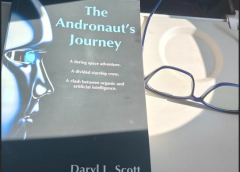I am not an avid reader of WW books and so this happens to be my second book first being War of Nerves by Jonathan B Tucker. The latter was based on chemical warfare from WWI to Al-Qaeda. The Pacific delves into the literature of WWII, starting from Pearl Harbor. Initially, I thought reading a war book won’t be that interesting that watching the movies but Ambrose proved me wrong. Majestically he illuminated the harrowing incidents of war and American history in front of my eyes.
Read MoreMagnetoSperm Microrobots for the Nanoworld: Biomimicry
Nature does not stop us marveling at its splendor be it at macro level or micro scale. There are limitless options to investigate and get inspired. Biomimicry is one such field in robotics, which is completely drenched with nature’s splash. Researchers do not leave any stone unturned when dealing with robos inspired from nature, lately a concept is put forward by experts at the University of Twente, Netherlands. They have taken inspiration from nature’s locomotion at microscale and have combined the process of two micro-scale entities like magnetotactic bacteria and…
Read MoreKepler-10c the mega-Earth Discovered: Godzilla of Earths
Space scientists have discovered a new planet to which they call as “Godzilla of Earths”, maybe because of its rocky exteriors. The exoplanet weighs more than 17 times that of Earth. Until now researchers believe that the planet is all solid and is much gigantic with respect to previous discoveries of super-Earth, hence it falls into the casket of mega-Earth. Sasselov, one of the astronomers believe that Kepler-10c, the newly found mega-Earth, is high on probability with respect to implications for life.
Read MoreThermometer for Ultrasensitive Measurements: Temperature Control
Physics researchers at the University of Adelaide have successfully created a rare thermometer, efficiency of which is thrice the existing best thermometers so far. Reporting further, the experts expatiated that they were able to gauge temperature with the ‘nano-Kelvin thermometer’, through an accuracy of thirty billionths of a degree. Researchers asserted that they have reached the highest level of precision in terms of measuring temperature at room temperature. Talking about the innovation, Professor Luiten one of the lead researcher said that temperature at subatomic level is not static rather fluctuating.…
Read MoreAugmentation of Cosmic Magnetic Flux by Turbulence: Interstellar Dynamics
Stellar physicists believed that escalation of interstellar space magnetic field could be an offshoot of the cosmic turbulence. Magnetic field pervades unanimously throughout universe however, there was no such thing around the beginning of Big Bang, which means the force has arisen from somewhere. In order to look for the answer, researchers at Rutherford Appleton Laboratory, UK simulated creation of supernova, a giant star with 60k billions times more powerful shafts, these rays were higher than the laser pointers. The study was based on identifying magnetic fields in the deposits…
Read MoreSprinting Robot Raptor based on Velociraptor: Faster than Cheetah
Whenever we talk about speed and agility, first thing that comes to our mind is Boston Dynamics Cheetah, which runs at a speed to about 45.5 km/h. Until now, none of the bots have been able to give tough fight to the big cat, however, it seems, researchers at KAIST are preparing to stand tall with their new sprinter, Raptor. It has shown an impressive speed of 46 km/h, which happens to be slightly more than the big cat. Wow! Experts at the Korea Advanced Institute of Science and Technology’s…
Read MoreNeuroprosthetic Devices on Deep Brain Simulation Technology: Implants to Restore Memories
A new initiative by the US military program focuses around treating defense personals from the after effects of being into war. In majority of cases, soldiers who come back from battle zones develop adjustment problems or psychiatric disorders to be more specific. For instance, combatants were diagnosed with “shell shock” during the era of WW I, “battle fatigue” during WW II and in Vietnam War, it was PTSD, post-traumatic stress disorder. Backed up by President Obama’s brain initiative, DARPA has received a funding of $70 million from the US to…
Read MoreCynicism is Directly Proportional to Dementia: Stop being Judgmental
The American Academy of Neurology recently brought about a health-related journal, where they postulated a direct relation between personality of an individual and dementia. The research carried an experiment, which demonstrated link between cynicism and dementia. During an eight-year period of the study, researchers examined nearly 1,450 individuals who were given tests for dementia and a questionnaire, with an aim of checking the respective level of cynicism. People having an average age of 71 were taken into account. The research was not limited to just one aspect but factors like high blood…
Read More10 Easiest Internet Tricks: Simplest Googling Tips to Remember
Lately, I realized that I have been using the following ten most simple tips while am working over internet. So I thought of jotting them down in form a post. Like me, some of you would find them equally interesting. I am sure, most of you have already know these tricks however, this post is for those who are still struggling and taking the long routes for particular tasks. So here we go, 1) Downloading music Type the following snippet into the google search bar. It’ll give you music downloads…
Read MoreLearning Process helps Survival of New Neurons: Using Brain at Optimal Levels
In an interesting study in the field of neuroscience, researchers have postulated that learning during the early ages of life helps in the survival of brain cells. Early learning also influence the functioning of brain cells after puberty claimed the same team. An experiment on rats demonstrated that brain cells that were exposed to learning survived with respect to the brain cells in animals that were not allowed to master a particular task. In addition, it was observed that the latter set of animals died quickly too.
Read MoreInternal Monitoring System Responsible for Neural Self-Regulation: The Most Complex Machinery
Parts of any machinery can be replaced, modified or tampered with only when the machine is in an off mode. It is nearly impossible to fiddle around with any operational part while it’s functioning. However, the same principle does not apply for our biological process, especially when we are talking about a nerve cell. This continuous rebuilding without affecting the overall operations has always been neuroscience’s biggest questions. Many theories have been put forward but none of them has ever reached any concrete census. Lately, Eve Marder, the Victor and…
Read MoreNano- Bots to Enter into the Arteries for Delivering Drugs: High-Performing Nanomotors
Very soon, we would be witnessing a 3D world on microchips. During the beginning of this year, researchers at Penn State University demonstrated the movement of nanomotors in controlled manner inside living cells. And now, experts at the University of Texas Austin have developed one of the fastest spinning and relatively longer shelf life nanomotor. The newly fabricated nanomotor has an ability of spinning continuously for nearly 15 hours with a speed of 18k rpm. This is an innovative product in the league where the existing nanomotors display an efficiency…
Read MoreEnergy Storage into Structural Materials: No More Power Cords for Devices
Researchers at Vanderbilt University have come up with an intriguing prospect that has complete essence of futuretech in itself. Their current interest hovers around the likelihood of a more technologically enhanced capacity for storing electrical energy directly across applications including but not limited to EVs, laptops and home appliances. They have demonstrated this idea by fabricating small wafers that have the potential of storing and discharging considerable amount of electricity while they are put through static loads or moving forces like vibrations or impacts.
Read MoreCloud Atlas by David Mitchell
Cloud Atlas presents dizzying rate of episodes across ages, times, continents and lives. The novel opens with the mid-19th century, where a ship is being sailing across some islands in New Zealand. We are here introduced with an American notary named Adam Ewing, his experiences with tribal people, his purpose of visit and most important of all, his acquaintance with a stowaway Moriori named Autua. All this is described via his mode of writing and maintaining a diary, in which all his encounters are vividly described. Second string of episode…
Read MoreStanford-MIT System Aims at Harvesting Low-Grade Heat: New Battery Technology
It’s been more than a decade researchers across the globe are working towards harnessing waste energy into something useful. Most of the times, their energy focused around thermoelectric devices but efficiency of this approach was limited to the accessibility of materials Lately, researchers at Stanford University in collaboration with experts from Massachusetts Institute of Technology have come up with an innovative technology, which captures and morphs waste heat into electricity. The approach holds the low temperature waste heat, that is, less than 100 degrees Celsius.
Read More
